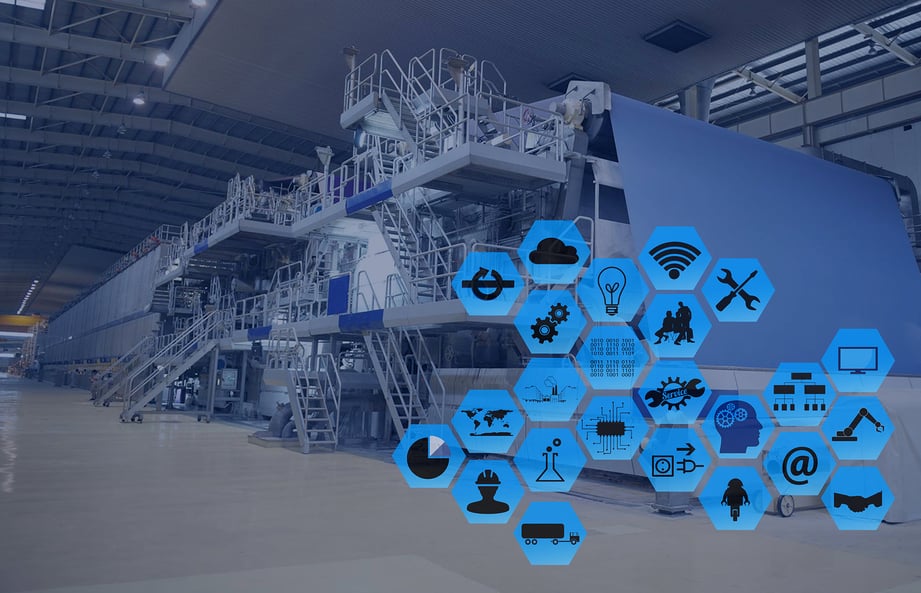
In recent years, the Industrial Internet of Things (IIoT) that has fascinated and revolutionized the sphere of industry has also influenced reporting.
In many cases, companies still tend to think that the more data they can gather, the wiser they are. This is not directly true: huge amounts of data stored deep in several systems do not serve the company. Data means nothing if it cannot be analysed and utilized to support the decision-making guiding the company’s operation.
In recent years, the Industrial Internet of Things (IIoT) that has fascinated and revolutionized the sphere of industry has also influenced reporting. As the use of IIoT spreads, data collection is becoming more efficient and more data are accumulated in industrial companies – which is good. For example, machine monitoring is applied to collect data on the operation of a manufacturing plant’s equipment and transfer the data to MES-systems used for manufacturing execution.
Dazzled by how easy it is to collect data, data are collected devoid of meaning and without thinking of how the data could be utilized in decision-making. Through the development of reporting, significant advantages can be achieved, thereby improving both the efficiency and competitive ability of industrial companies.
Three most common stumbling blocks in reporting

The meters should always be based on the company’s strategy and objectives. In practise, linking the meters to the strategy is successful when the management identifies actions needed to achieve the goals.
Understanding acquired via reports helps to make the right decisions leading the company to the direction desired and strengthening its competitive ability. Because of this, it pays to invest in reporting development. Here are the three most common reporting challenges encountered by industrial companies:
1. The meters do not comply with the company’s objectives
Saying “You get what you measure” has a meaning. Make sure what you get matches what you are aiming for. The meters should always be based on the company’s strategy and objectives.
In practise, linking the meters to the strategy is successful when the management identifies actions needed to achieve the goals. When the goals have been divided into smaller entities to the shop floor level and the job responsibilities of each production worker, the common direction is clear. Each employee can see how he or she contributes to the achievement of common strategy.
Goal-setting meters that guide day-to-day work are, in fact, a great way to implement strategy to different organizational level and in a way that is understandable.
2. Knowledge is fragmented
Industrial companies use numerous different IT systems containing data important from the viewpoint of decision-making and leadership. For example, ERP, production planning system, and maintenance system and the millions of excels.
Data fragmented among several systems, databases, files, and reports are not available at the time and place they are required. It should be possible to compile data from several data sources for analysis and utilization, so that the data could be used for making of decisions guiding the company’s entire operation.
3. Technology does not correspond to reporting needs
Successful reporting requires the appropriate tools. The multiple reporting needs of different levels and functions of an organisation constitute their own challenge: reports are required to support various decisions both inside the company and among stakeholders.
System report templates prepared in advance are rarely capable of meeting these differing and constantly changing needs. For example, at the shop floor level, different reports are required for operation support as compared to production management, let alone to the company’s Board of Directors.
In the sphere of industry, the real-time nature of data is emphasized. Particularly in production, it is extremely important to have access to shop floor status to quickly identify and respond to problem areas.
If a suitable technology is lacking, reports are often compiled manually, which is quite time-consuming and error-prone. The resulting reports are disposable and static; they do not provide significant and sufficiently detailed information required for data analysis and decision-making.
In the sphere of industry, the real-time nature of data is emphasized. Particularly in production, it is extremely important to have access to shop floor status to quickly identify and respond to problem areas. An example of this is sticking to a production plan. A static report compiled afterwards does not support active monitoring and development.
Pinja offers support for industrial reporting
Does your company need help with data analysis, reporting, and visualization? Pinja offers data utilization solutions for both medium-sized companies and large companies. We are at the service of our customers in case of challenges related to data warehousing, data collection, IoT-analytics,advanced analytics and forecasting ans business intelligence. Click here for more information on our data-based management services!
Read more

Petteri Väisänen
I lead Pinja’s BI unit, where we enable our clients to be truly data-driven. The most important thing about my job is the spirit and the work ethic of our team. I enjoy my free time with my family, where the spirit of doing is also very much present. In addition, boardsports and, actually, all sports are close to my heart.
Back to the Pinja Blog
Categories
- Pinja Career (63)
- Production development (39)
- Software development (39)
- Business Intelligence (35)
- Digital business (30)
- Circular economy and natural resources (26)
- Sustainability (26)
- Ecommerce (21)
- Digital society (20)
- Industrial digitalization (19)
- Maintenance development (19)
- Supply chain management (19)
- ERP (18)
- ICT services (18)
- Industrial innovation (11)
- Health and welfare technology (9)
- Forest industry ERP (8)
- Lean (4)